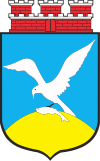 54°27' N 18°34' E, 182.0 miles NNW of Warszawa. Sopot is a major health-spa and tourist resort destination with the longest wooden pier in Europe, at 515.5 metres, stretching out into the Bay of Gdańsk.
54°27' N 18°34' E, 182.0 miles NNW of Warszawa. Sopot is a major health-spa and tourist resort destination with the longest wooden pier in Europe, at 515.5 metres, stretching out into the Bay of Gdańsk.
Wikipedia [Jan 2015]
CEMETERY:
- burial list [Jan 2015]
- The 0.5-hectare cemetery in ul Malczewski founded in 1913 is the burial place of members of known families of Gdansk: Dancinger, Fridman, and Biełous. Remaining are ravestones with inscription in Polish, German, Russian and Hebrew from 1922 -1936, ohel fragments, and the old fence with a legend above in Hebrew: "This is the gateway to God" At the cemetery is a monument dedicated to Jewish soldiers. Local authorities and Nissenbaum Foundation restored the cemetery area. photos. [July 2009]
- US Commission No. POCE00004
Alternate name: Zoppot (German). Sopot is located in Gdansk at 54º26.2818º34 [sic], 11km from Gdansk. The cemetery is located at ul. Malczewskiego. Present town population is 25,000-100,000 with 10-100 Jews.
- Town: Prezydent Miasta, Urzad Miasta, ul Kosciuszki 25-27, 81-704 Sopot, Tel. 51-20-21 centrala.
- Regional: Wojewodzki Konserwator Zabytkow, ul Kotwicznikow 20, 80-881 Gdansk, Tel. 31-62-67, 31-62-68 centrala.
- Local: Dr. Hanna Domanska, ul. Wladyslawa IV 34/3, 81-742 Sopot, Tel. 51-04-22.
- Interested: Regionalny Osrodek Studiow i Ochrony Srodowiska Kulturowego, ul. Sw. Trojcy 5, 80-822 Gdansk, Tel. 31-77-12, 31-75-22.
- The earliest known Jewish community was 1913. 1938 Jewish population was 130. The Jewish cemetery was established in 1913 with last known Orthodox or Progressive/Reform Jewish burial in 1936. Landmark: Register of Monuments of the Province Conservator of Monuments, no. 894. The urban hillside, separate but near other cemeteries, has a Polish and Hebrew sign indicating the date that the cemetery was established, the restoration dates, and the restoration sponsors. Reached by turning directly off a public road, access is open to all with a continuous masonry wall and non-locking gate. The size of the cemetery before World War II was 1.0 hectares. It is currently 0.5 hectares. The decrease resulted from detaching of the reserve area in 1963. 20 and 100 stones, less than 25% toppled or broken, date from 1920. The marble, granite and iron flat shaped stones, finely smoothed and inscribed stones, or double tombstones have Hebrew, Polish, German, and Russian inscriptions. The cemetery contains special memorial mounuments to Jewish soldiers. There are no known mass graves or structures. Municipality owns property used for Jewish cemetery. Properties adjacent are forest and a Catholic cemetery. Frequently, organized Jewish tours or pilgrimage groups, organized individual tours, private visitors, and local residents stop. The cemetery was vandalized occasionally, but not in the last ten years. Local/municipal authorities and the Fundacja Nissenbaum re-erected stones, patched broken stones, cleared vegetation, and fixed wall and gate in 1961 and between 1983-1989. No care. Water drainage is a seasonal problem. Security (uncontrolled access) and vandalism are moderate threats.
- Dr. Hanna Domanska, ul. Wladyslawa IV 34/3, 81-742 Sopot, tel. 51-04-22 completed survey in 7/91. She visited in July 1991. Documentation: her text, The Tree of Stone Tears; The Jewish Communities of the Gdansk Vovoidship; Their History and Culture. (Gdansk, 1991).
